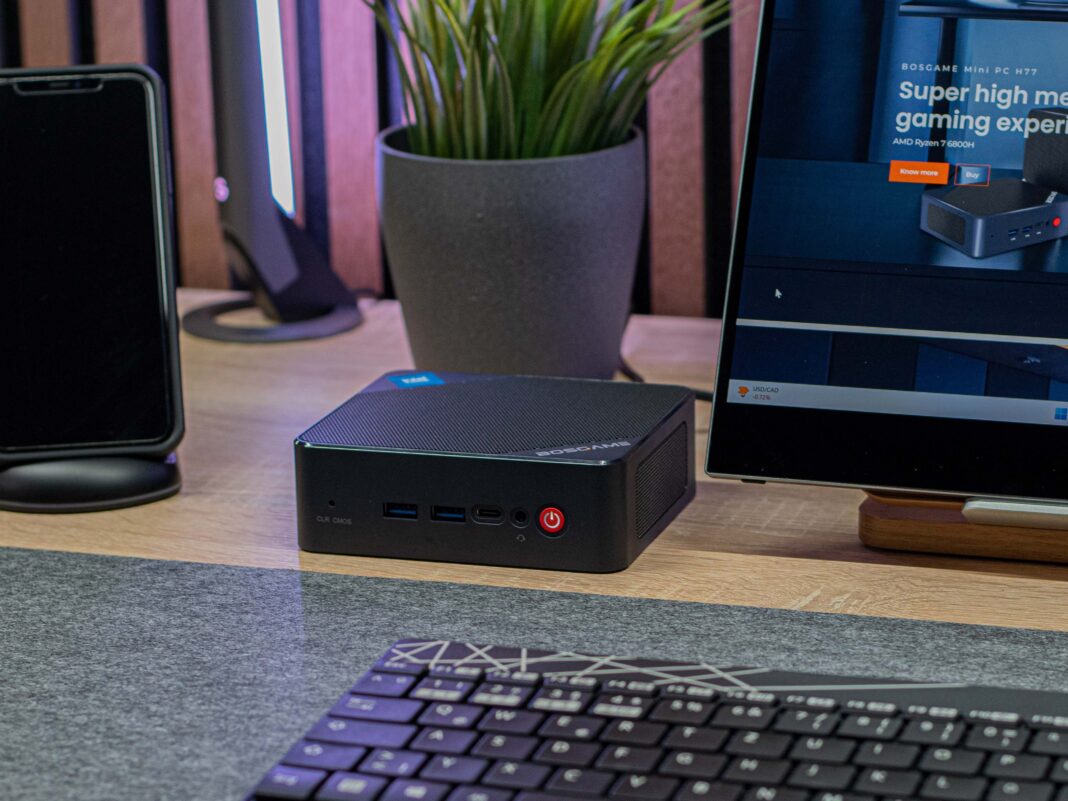The Bosgame Mini PC consists mainly of plastic but this is quite acceptable considering its price. Nevertheless, the manufacturer has not opted against using metal for the mesh which supplies fresh air to the system. This is integrated into the sides and the top of the device and, design-wise, they fit perfectly with the overall look.
Although we are mainly dealing with a low-priced device, the fit and finish are good and without criticism. The case has been given a blue-gray-toned lick of paint and the fan grilles are anthracite in color. Visual highlights, if they can be called that, are the Bosgame lettering on the top of the machine as well as the power button on the front.
This comes across as an emergency stop button due to its striking red color. Weighing in at just under 400 grams, the Bosgame is a little heavier when compared to the NiPoGi GK3PLUS . Despite this, we see the Bosgame as having a clear advantage over the competition as the device is considerably more compact and takes up much less desk space.
Anyone on the hunt for an even more compact Mini PC should take a look at the Ace Magician T8Pro . Many very small computers can be fixed to the back of a monitor with the help of a VESA mount. Bosgame also offers this possibility and everything you require for its installation can be found in the box.
Basically, Bosgame offers all the important external ports. There are a total of 4x USB-A and two HDMI ports with support for 4K60. This means we are dealing with almost the same specs as the NiPoGi GK3PLUS .
Nevertheless, the Bosgame has one distinct advantage as a USB-C port is included. Housed inside the Bosgame is an Intel Wi-Fi module which also supports Bluetooth 4. 2.
Unfortunately, the installed module is unable to serve the more up-to-date 6 GHz range with which we documented the 5 GHz frequency band transfer speeds in our test. Compared to the NiPoGi GK3PLUS , the Bosgame does significantly better in this area. The transfer speeds are not record-breaking but are more than sufficient for everyday use.
For our performance tests, we used our test router, the Asus ROG Rapture GT-AXE11000. With the RJ45 interface, we have a considerably faster alternative to wireless network communication. Using this, data can be transferred at up to 2.
5 GBit/s. Out-of-the-box, the Mini PC comes with a 30-watt power adapter as well as an HDMI cable and mounting plate to allow the device to be optionally fitted to a monitor (VESA mount). Likewise, the manufacturer has included a connector cable for the installation of a 2.
5-inch mass storage device. Basically, it is possible to carry out maintenance tasks on the Bosgame Mini PC. In order to do this, the base of the device can be opened relatively easily.
The base plate is secured by four small screws. However, expansion possibilities are limited to the installation of only one additional 2. 5-inch format mass storage device.
The Wi-Fi module, the M. 2 SSD and the RAM are all swappable. The Intel Pentium N95 is a native quad-core SoC and provides a solid foundation for its intended use.
8 GB of RAM can be described as good and this should be the minimum standard in 2023. Since there is only room for one module, it is unfortunately not possible to use dual-channel mode. We carried out all of the performance tests using the Highest Performance energy profile.
Differing energy-saving plans only came into play in the power consumption measurements as well as the volume measurements. Additional details relating to our test criteria can be found here . With the Intel N95 , our review sample has been fitted with a relatively up-to-date SoC which was only launched at the start of the year.
The four native computational cores achieve a maximum boost speed of up to 3. 4 GHz. Our test shows that the Bosgame device is able to coax considerably more power from the Intel N95 than the NiPoGi GK3 Plus N95 .
Around 10 percent more power is good and hints that the Bosgame possesses a significantly better cooling system. At only nine percentage points, the gap to the native 6-core chip found in the Newsmay S2-B560 is small and once more emphasizes what kind of power the extremely economical SoC has to offer. When it comes to the power limits, the Bosgame allows the Intel N95 to briefly consume up to 35 watts, although this limit is set to 15 watts under continuous load.
Nevertheless, the N95’s power delivery isn’t quite optimal. Some performance is wasted when it comes to the installed RAM which only works in single-channel. Unfortunately, a dual-channel option is also not possible since there is only one SODIMM slot.
Furthermore, Bosgame should have also opted for 4,800 MT/ s DDR5 RAM in order to squeeze as much as possible from the small SoC. In terms of the RAM tests, it is therefore unsurprising that our review sample can only manage a mid-table placing. Despite this, we also observed that the Bosgame is faster than the NiPoGi GK3 Plus N95 .
It doesn’t take long to find out the reason why since the competitor works with the slower 2,666 MT/s DDR4. Additional processor benchmarks can be found here . With the Cinebench R15 continuous loop, we get our first insight into the installed cooling system’s capabilities in cooperation with the N95’s power target.
First of all, we can see the Intel N95 performing very stably in all four runs. However, the SoC is not provided with more than 14 watts, although, at up to 35 watts, the power target allows considerably more leeway. With the performance documented here, the Bosgame grabs second place behind the Newsmay S2-B560 which offers better multi-core performance due to its installed 6-core chip The Bosgame also benefits from its good CPU performance in our system performance benchmarks.
Once again, our test system is able to secure second place and push the NiPoGi GK3 Plus N95 down into third place. With the help of its native 6-core chip, the Newsmay S2-B560 scores more points in PCMark 10 and Crossmark thereby securing first place in our comparison – and by some margin. When it comes to the RAM tests, the Bosgame is not competitive as a result of its already highlighted disadvantages.
When it came to the NiPoGi GK3 Plus N95 , we recorded even worse results due to its low RAM speed. The latencies documented here already appeared when opening multiple Edge tabs. Both our 4K test video playback and Prime95 were unable to cause a further increase.
We also saw a number of dropped frames in the 4K video playback which occurred shortly after starting the video. There were no further difficulties and we recorded around 30 percent utilization for the iGPU, and, in the device comparison, the Bosgame secured third place. Our review device houses a mass storage device from Kingston.
This uses the M. 2 interface and offers a storage capacity of 256 GB. However, the model installed here has significantly limited performance due to the low connection.
Nevertheless, in our tests, we still saw slightly better results than conventional SATA SSDs. Despite this, evaluated subjectively, the performance is sufficient for everyday use. The test revealed stable performance even during continuous read accesses.
Only the Nofflink M500 stands out in comparison and doesn’t score well when it comes to performance stability. Anyone searching for more than 256 GB of storage can do so by installing an additional 2. 5-inch storage device.
For additional comparisons and benchmarks, take a look at our comparison table . The Bosgame’s graphics solution comes in the form of Intel UHD Graphics with 16 EUs and, as part of the Intel N95, it only delivers low 3D performance. In the comparison, this only helped our review device secure third place.
Only the Newsmay S2-B560 offers more power. Additional Intel UHD Graphics benchmarks can be found here . We can’t recommend the Bosgame as a gaming solution due to its low 3D performance.
Playable frame rates are only occasionally achievable in older games and at the lowest resolutions and low details. Mini PCs equipped with an AMD Ryzen 9 6900HX offer noticeably better performance. These include devices such as the Geekom AS 6 , the Morefine M600 or the Ace Magican AM08 Pro .
The installed cooling system is not large but consistently operates very quietly. In both idle use and under load, we recorded very low noise levels. The maximum we measured was 31.
4 dB(A) which is the second-best result among the actively cooled devices in our comparison. Only the Ace Magician T8Pro delivers better scores in this area. We didn’t observe any high temperatures in the Bosgame device either in idle use or under load.
The fresh air used for cooling the SoC is sucked in through the case openings on the top of the device and expelled from the case rear. In the stress test, we recorded a maximum SoC temperature of 69 °C. This leaves a lot of leeway that the manufacturer could have better utilized with more aggressive power management.
In a worst-case scenario, we only saw 20 watts even though up to 35 watts would have been possible without violating the manufacturer’s specifications. Our Bosgame review sample proves very clearly that we are dealing with a very economical Mini PC. Our measuring device only measured 3.
5 to 6. 2 watts in idle use. That is significantly more energy efficient than the comparison devices here in our tests.
On average, we recorded an almost identical 20 watts compared to the NiPoGi GK3 Plus N95 with the same SoC. The power adapter can provide up to 30 watts. This leaves some scope for an optional second storage device since we only recorded a maximum of 25 watts at short peak loads.
With the Intel N95 , the Bosgame gets a brand new and at the same time economical Alder Lake N SoC. In tests, the small 4-core machine managed to get the Intel Core i5-11400T -based competition hot under the collar. However, in terms of pure multi-thread performance, the quad-core processor has to bow to its 6-core counterpart.
The Bosgame has the NiPoGi GK3 Plus N95 largely under control and the reason for this can be traced back to it having better RAM specs. Despite this, we see the Bosgame’s installed RAM as being the biggest point of criticism. According to the manufacturer’s specs, 3,200 MT/s is already the optimum when using DDR4 RAM.
However, at 4,800 MT/s, the faster DDR5 RAM is also supported and this is something the whole system would benefit from. Based on the Intel N95, the Bosgame N95 offers solid everyday performance. In addition to its low emissions, the Bosgame N95 also impresses with its very low price tag.
We have no complaints when it comes to the build quality, even though the case mainly consists of plastic. The good selection of ports is also worth mentioning. The installed Wi-Fi module is, however, worthy of criticism because, in our opinion, a more modern Wi-Fi 6 module would have been the better alternative.
In the Bosgame N95, you get a good office PC for an asking price of $160 – and one that is very economical without creating a great deal of background noise. In tests, our N95 was almost always nearly silent. At around $250, the NiPoGi GK3 Plus N95 costs somewhat more than our review device but offers more in the way of RAM and storage.
The Bosgame Mini PC Intel 12th can be currently had on Amazon for around $160 . .
From: notebookcheck
URL: https://www.notebookcheck.net/Bosgame-Mini-PC-review-An-affordable-Mini-PC-with-an-Intel-N95-for-everyday-office-use.737678.0.html



